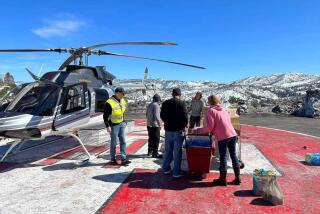Air National Guard Gives Wing to Southland Goodwill
- Share via
Southern California’s goodwill effort for victims of hurricane-ravaged Central America continued Monday when 50,000 pounds of donated food and medical supplies destined for Honduras were loaded into two C-130 cargo airplanes at Los Alamitos Naval Air Station.
“We get a lot of satisfaction doing this kind of flying,” said Capt. Keith Chikasawa, 30, of Camarillo, a pilot with the 146th Airlift Wing at Channel Islands Air National Guard Station at Port Hueneme.
Gov. Pete Wilson authorized the National Guard deployment to Honduras and Nicaragua on Nov. 15.
In addition to ferrying supplies, lumber and construction equipment, the airlift later will include a medical evacuation team to administer inoculations and give medical assistance in the devastated areas.
“So far, we’ve made seven trips to Central America since the airlift began,” said Capt. Diane McKinzy, Air National Guard spokeswoman. “Our squadron plans to fly 12 relief missions in two weeks.”
Typically, squadron pilots such as Chikasawa have flown their aircraft from Port Hueneme to various air bases on the East and Gulf coasts. Once loaded with relief supplies, they head for Central America. Monday was only the second time the squadron has used the base at Los Alamitos as a depot.
The two cargo planes flew to Kelly Air Force Base near San Antonio, where they refueled and remained Monday night. Today, the aircraft are headed to Central America and are expected to land at Col. Enrique Soto Cano, an Honduran air base about 45 miles northwest of Tegucigalpa.
In Honduras, an estimated 7,000 people have died and more than a third of the country’s population of 6 million are now homeless as a result of the devastation from Hurricane Mitch, which struck Central America on Oct. 29.
At its height, Mitch had winds of 180 mph, making it a Category 5 hurricane, the most powerful and dangerous. The U.S. National Weather Service said only three Atlantic storms have been stronger--Gilbert in 1988, Allen in 1980 and the Labor Day hurricane of 1935.
The Air National Guard’s mission will be brief in Honduras itself, McKinzy said. With such a huge international relief effort underway, air and ground space is extremely cramped flying into Honduras. In addition, a health risk exists from airborne diseases because of the unburied bodies.
As a result, incoming flights are limited to the time it takes to unload, refuel and takeoff, Chikasawa said.
“We only have one- to two-hour ground time,” Chikasawa said. “With so many aircraft, they don’t want too many airplanes remaining on the ground.”
It is Chikasawa’s third trip to Honduras.
“I had flown to Honduras before Hurricane Mitch struck,” Chikasawa said. “I remembered seeing rivers about a quarter of a mile wide. But when I flew in after the storm, the same rivers are now two to three miles wide. It really tore it up pretty good.”
Aboard Chikasawa’s aircraft were about 25,000 pounds of food, including rice, pasta, powdered milk and cereal. In addition, they loaded medical supplies such as aspirin, gauze and over-the-counter medications for everything from colds to headaches, donated by Southern California residents.
“We couldn’t carry any heavy items such as water and canned goods. Those will go on another plane,” said Senior Airman Albert Sherring, who helped load the aircraft. “They wanted to load up as much as they could carry. We will not have any medical staff, so they can just hand out the food and medication without having a doctor on board. If somebody has a headache, we can just hand them the aspirin. It’s faster.”
The 146th Airlift Wing has provided emergency relief in the aftermath of numerous disasters in California and around the world. The unit has 12 C-130 Hercules aircraft and more than 1,200 guard personnel.
It delivered emergency supplies and personnel after heavy flooding devastated areas of Northern California in 1994 and 1995. It was the first Air National Guard unit to reach the Hawaiian Islands after Hurricane Iniki swept through leaving a path of destruction in 1992.
More to Read
Sign up for Essential California
The most important California stories and recommendations in your inbox every morning.
You may occasionally receive promotional content from the Los Angeles Times.













